Perfect Pan-Seared Duck Breasts with Port Wine Sauce
This post may contain affiliate links. Please read my disclosure policy.
This duck breast recipe comes together so quickly, looks so beautiful, and is so tasty: perfectly crisp skin and flesh medium-rare. The sauce is restaurant caliber. Date night at home? Open a bottle of wine and start cooking!
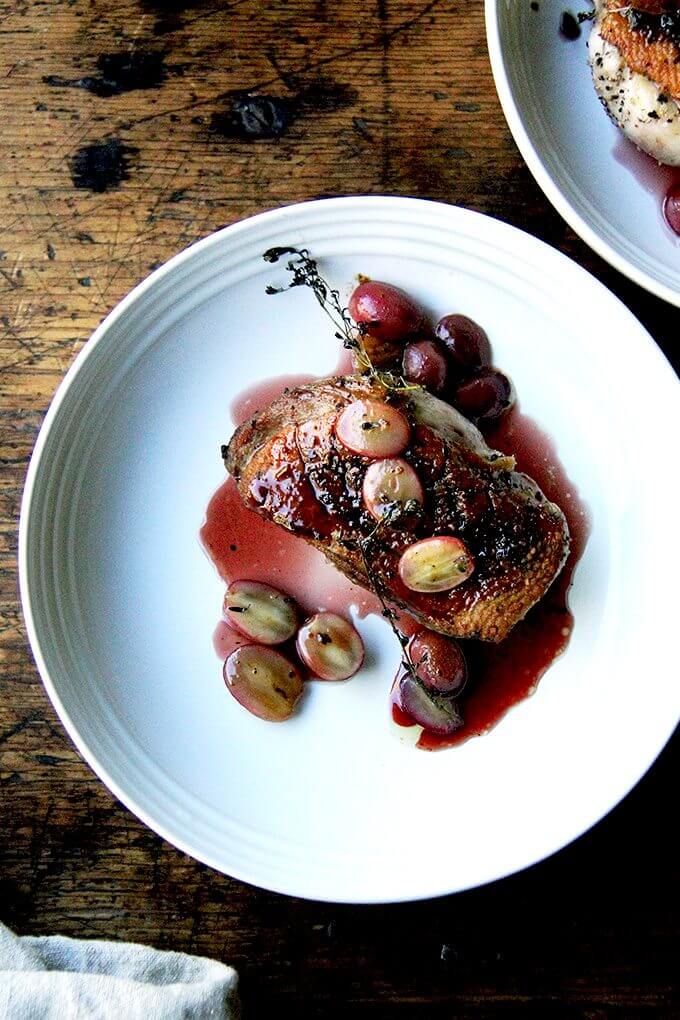
Several weeks ago, I had dinner at Otway in Brooklyn. Chef Claire Welle prepared a fall meal in collaboration with Le Creuset and Cherry Bombe in anticipation of the now-released Le Creuset Cookbook and tableware collection. Of the many memorable dishes Claire cooked for the event, several came from the Le Creuset Cookbook itself, including one of my favorites of the evening: duck breast with banyuls gastrique.
As I swiped each piece of duck through the ruby red sauce pooling on the plate, I remember thinking: Only in a restaurant is duck ever this good, the meat this perfectly cooked, the sauce this flavorful. When I turned to the recipe in the Le Creuset Cookbook, I expected to see a list of elusive ingredients and a note saying: sous-vide machine required.
On the contrary, the recipe looked simple, the sauce requiring three ingredients, the duck an oven-proof skillet. I was intrigued by the technique, too:
“Instead of slapping the duck into a screaming hot skillet, scored breasts are placed skin-side down in a cold pan, slowly brought up to temperature, and left undisturbed until they render copious amounts of delicious fat and the skin turns deep brown and crisp.”
Cold. Pan. Did you catch that?
I’ve now made the dish complete with fancy sauce and thyme-roasted grapes several times, and every time I am surprised by how quickly it comes together, how impressive it looks, and how tasty it is. I’ve never cooked better duck at home, with skin beautifully crisp, flesh medium rare, the sauce restaurant caliber. What’s more? It turns out the secret to perfectly cooked duck at home is also the key to not smoking out your house. Win win.
What is a Gastrique?
In short: it’s a delicious Port wine sauce. Moreover: it’s nothing to be intimidated by.
If you’ve made a caramel sauce — and even if you haven’t — you can make a gastrique. Here’s the basic process:
- Melt sugar with water in a small saucepan, and cook it until it turns pale gold.
- Add vinegar (Banyuls, if you can find it, red wine, if you cannot).
- Add fortified wine (Banyuls, if you can find it, Ruby Port, if you cannot.)
- Simmer until the sauce reduces to a consistency that will coat the back of a spoon.
As the sauce simmers, it reduces into an irresistibly sweet-sharp syrup, tasting like an expensive aged vinegar. In the end, you will feel you have a pot of gold on your hands, a sauce to make anything better.
With the sauce done, there is nothing tricky about the dish. When the breasts are finished cooking, they, like all meat, must rest, at which point you throw a handful of grapes and a few sprigs of thyme into the now-empty pan and then toss the pan into the oven. Genius! Just the distraction you need to keep you from slicing the duck prematurely.
Duck is rich, like steak, so I’ve been serving the breasts with a simple green salad dressed with a shallot vinaigrette and bread, of course. This meal is dinner-party worthy though weeknight (if you like to do it up) friendly — if you make the sauce ahead of time, the meal comes together in about 20 minutes.
How to Make a Gastrique (Port Wine Sauce)
- Gather your ingredients: sugar, vinegar, Ruby port or Banyuls:
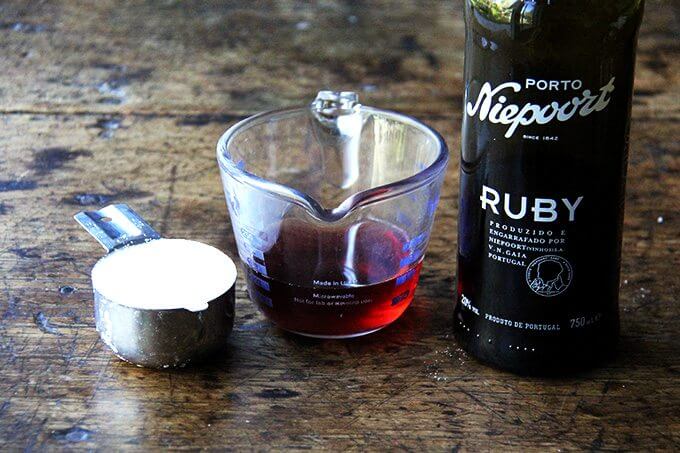
2. Caramelize the sugar:
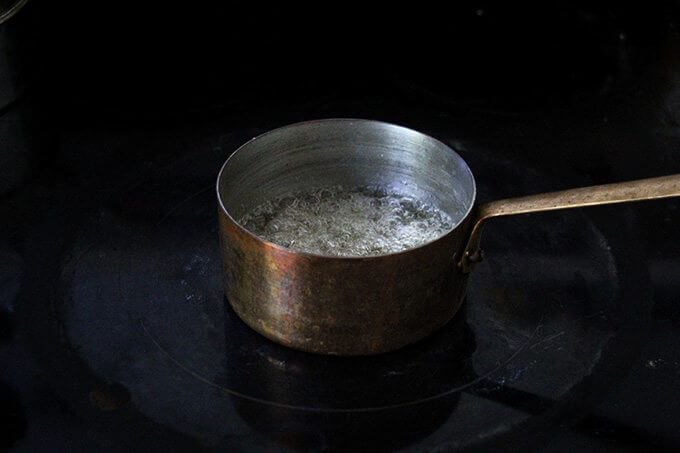
3. Add the vinegar, at which point, the sugar will harden, and you will feel you are doing it all wrong…
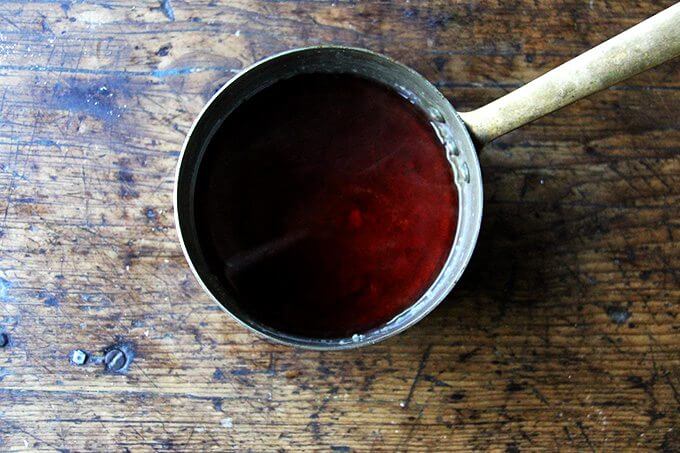
4. …but after a brief simmer, the sugar will melt, you’ll add the Port or Banyuls and simmer for 10 more minutes, at which point the sauce will begin coating the back of a spoon, a sign you have a most delicious, sweet-sharp syrup in the house… woot woot!
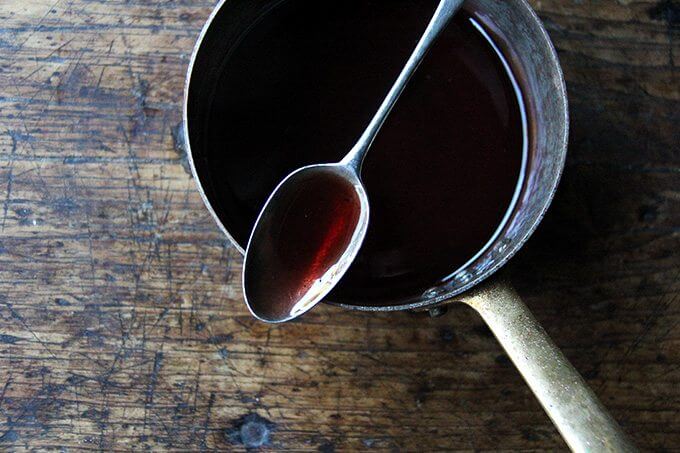
How to Make Perfect Pan-Seared Duck Breasts
- Score four duck breasts.
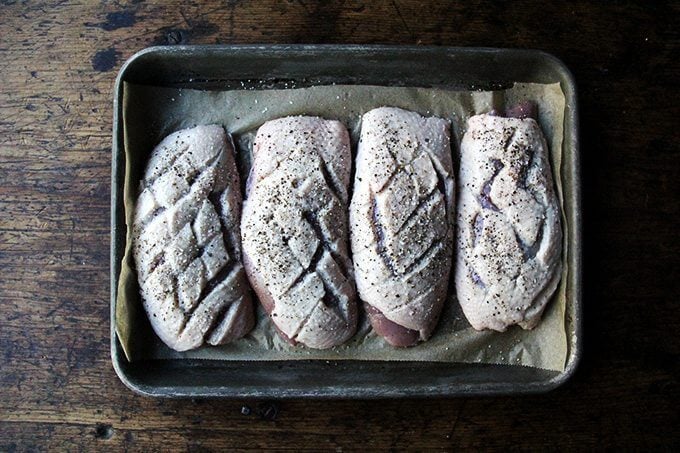
2. Place them in a cold skillet. (This, by the way, is my new favorite pan. It’s 5 qts, which is to say it can fit a lot of food at one time. Moreover, it distributes heat evenly, it cleans like a dream, it’s oven-safe, and it’s nice to look at to boot. Seen previously here and here.)
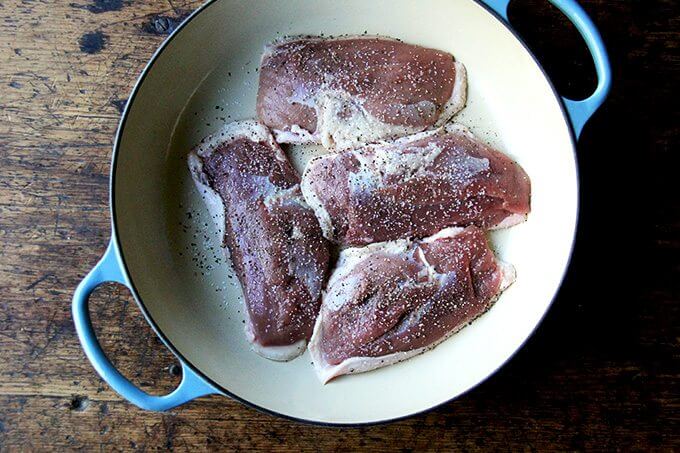
3. Render the fat, then cook until…
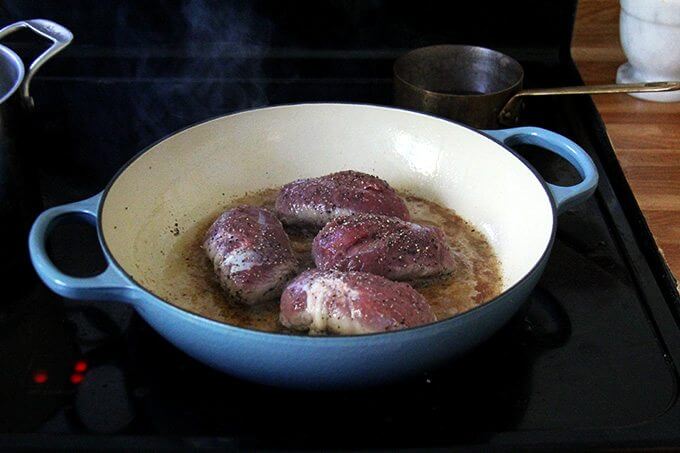
4. … the skin is crisp and in instant-read thermometer — can’t say enough about my Thermapen — registers around 130ºF for medium rare. Transfer duck breasts to a plate to rest.
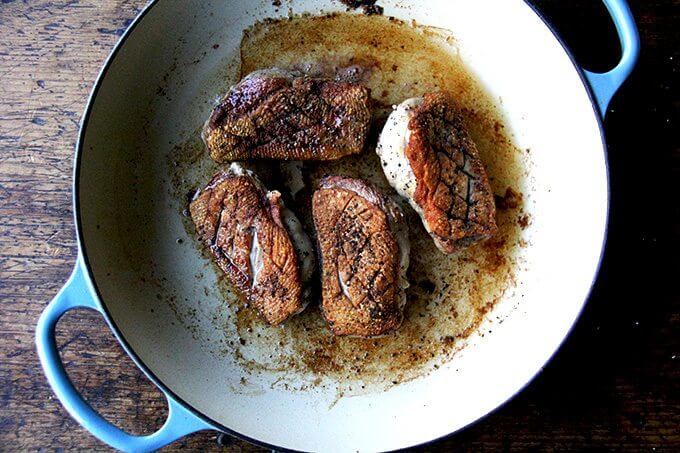
5. Add grapes and thyme to the pan and roast while the duck rests.

6. Spoon grapes and gastrique over breasts, then …
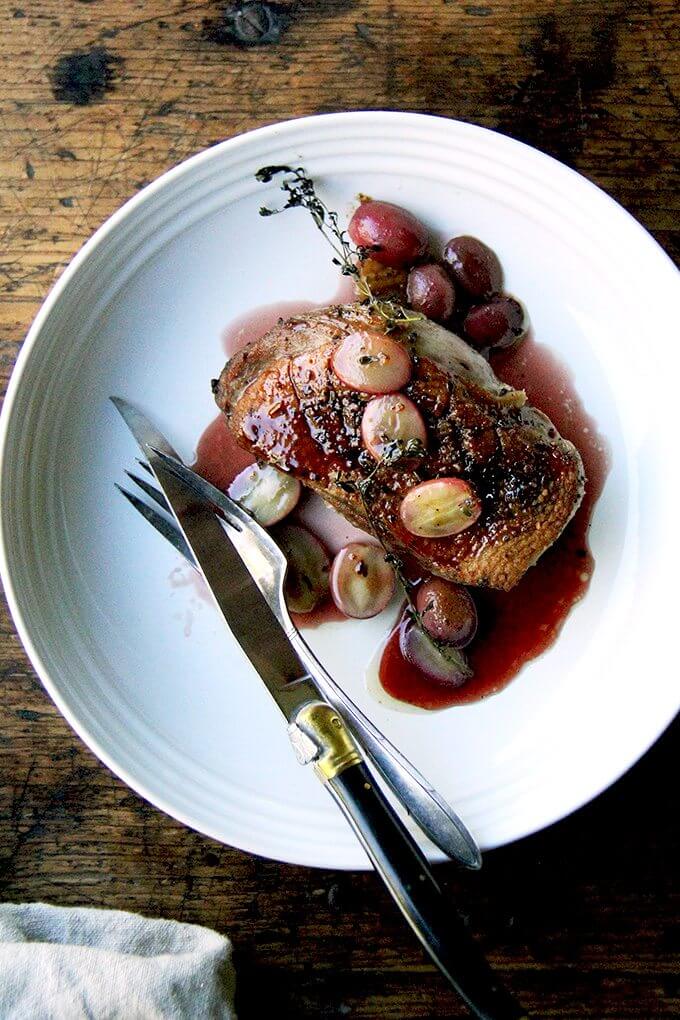
… gather your favorite people around the table.
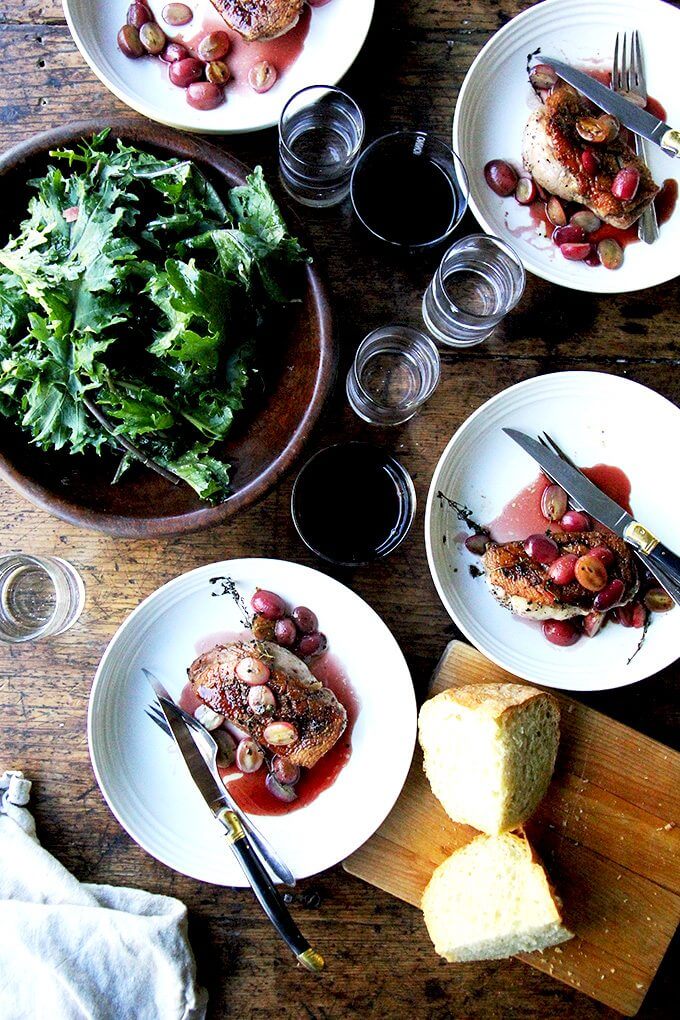
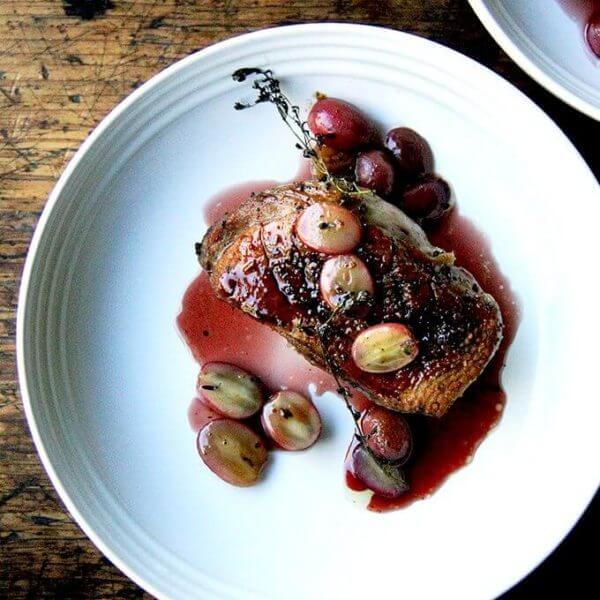
Perfect Pan-Seared Duck Breast with Roasted Grapes & Gastrique
- Total Time: 1 hour
- Yield: Serves 4
Description
Adapted from the Le Creuset cookbook (pronounced l’uh • cru • say)
A few notes:
This summer I invested in a good instant-read thermometer: a Thermapen. I can’t recommend this tool enough. Duck breasts in particular have been a challenge for me to cook — so many times I’ve pulled them from the heat, let them rest, only to cut into them to find flesh too rare or way overcooked. What is hard about cooking meat like steaks or duck breast is that when you get that good sear, it’s misleading — the meat may feel firm to the touch, but you might only be feeling your nice sear … what lies beneath is a guess. The Thermapen takes the guesswork out.
I do not use the star anise, because the first time I made this, I didn’t have any on hand, and I absolutely loved the flavor of the sauce as it was, so I’ve since omitted it. I imagine a single star anise would impart a very nice, subtle spice to the sauce, so absolutely use it if you have one on hand.
Finally, if you have a hard time finding duck, D’artagnan is a great source. I’ve sampled all of the duck varieties they sell. The Muscovy is the tastiest. It’s pricey, but if you think about what it costs to eat duck breast out at a restaurant, it’s not so bad.
Ingredients
- 1/2 cup sugar
- 2 tablespoons water
- 1/2 cup Banylus vinegar or red wine vinegar
- 1/4 cup Banylus fortified wine or ruby port
- 1 star anise pod, optional
- 4 boneless duck breast halves with skin
- kosher salt to taste
- fresh cracked black pepper to taste
- 1.5 cups halved red seedless grapes
- 1 teaspoon chopped fresh thyme (or a few sprigs if you are lazy)
- 1 cup loosely packed mâche or watercress leaves, optional
Instructions
For the gastrique:
- In a small saucepan over medium-high heat, cook the sugar and water, swirling gently until the sugar dissolves and the mixture turns a pale golden color, 8 to 10 minutes. Lift the pan from the heat and pour in the vinegar. The caramel will bubble vigorously and possibly seize and harden. Return the pan to the heat and cook until the caramel is melted and smooth, 2 to 3 minutes. Add the wine and star anise, if using. Simmer until the liquid reduces to thin syrup, about 10 minutes. Discard the star anise. Keep the gastrique warm over very low heat until ready to use.
For the duck breasts:
- Blot the duck breasts dry. Use a sharp knife to score the fat of each in a diamond pattern, taking care not to cut into the meat. Season both sides of each breast generously with salt and pepper, then place them skin side down in a large, cold skillet. Place the skillet over low heat and cook for 3 minutes. Increase the heat to medium, and continue cooking until the duck begins to sizzle. Continue cooking undisturbed until the skin is browned, crisp, and has rendered most of its fat, 6 to 8 minutes.
- Heat oven to 350ºF.
- Spoon off and reserve the fat from the skillet. Flip over the breasts and transfer the skillet to the oven. Alternatively, flip the breast and cook stovetop until the breast registers 125ºF-130ºF. I prefer finishing the breasts stovetop as I feel I have more control/vision on when the breasts look done, at which point I test with my instant-read thermometer. For me it’s been about 2 minutes on the second side. If you place pan in oven, roast for 2 to 4 minutes or until an instant-read thermometer inserted into the thickest part of the breast registers 125ºF-135ºF — Note: I find 125ºF-130ºF to be about right for medium rare. Transfer breasts to a plate to rest.
- Add the grapes to the skillet and toss with the thyme and a pinch of salt and pepper. Roast in the oven until the grapes are hot and wrinkled in spots, 8 to 10 minutes.
- Transfer breasts to plate, spoon grapes over top. Spoon sauce over top. Top with a small handful of mâche, if using, and serve immediately.
- Prep Time: 20 minutes
- Cook Time: 40 minutes
- Category: Dinner
- Method: stovetop
- Cuisine: French
This post may contain affiliate links. Please read my disclosure policy.

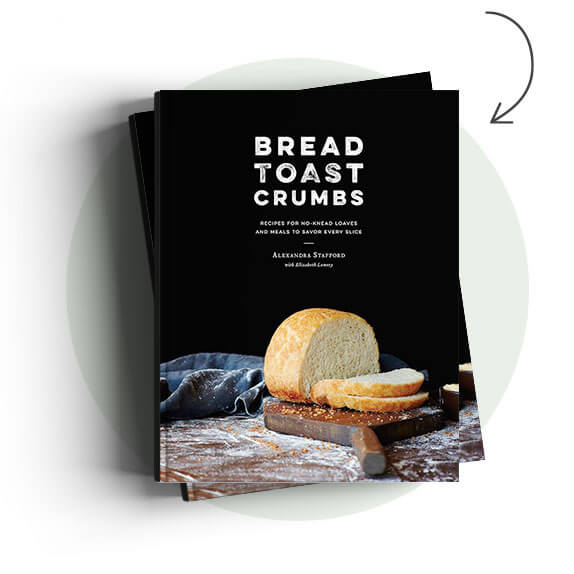

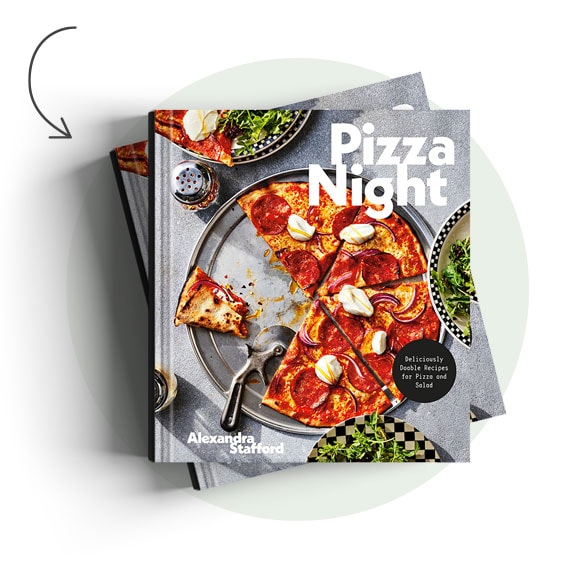
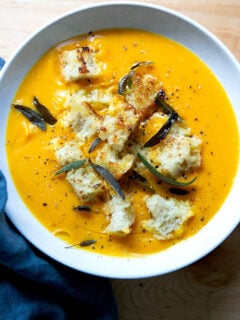
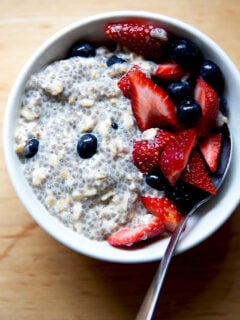
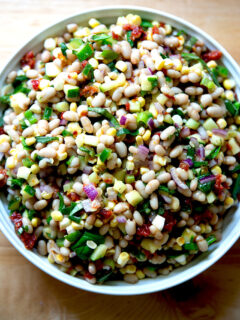
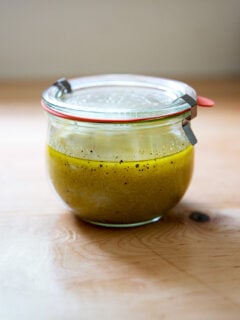
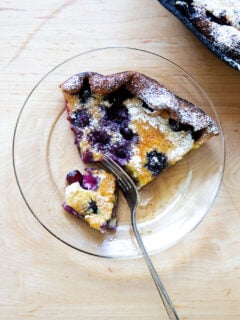
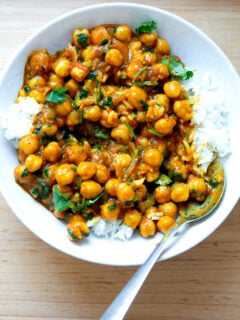

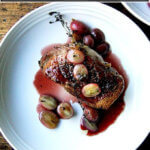
365 Comments on “Perfect Pan-Seared Duck Breasts with Port Wine Sauce”
I’m curious how the grapes go with it-may have to try the recipe to find out for myself!
This looks amazing! I always avoid cooking duck at home because it seems so tricky. Will absolutely be giving this a try.
That recipe makes my mouth water!
Beautifully done both recipe-wise but also the plating is superb!
I love Le Creuset!
Have never cooked duck breast but this certainly looks like it is worth a try.
This looks delicious! I have never cooked duck, but have always wanted to find something fancier to make to impress my friends ?. Thanks for the recipe!
I’ve been slowly building my small Le Creuset collection, but there still one or two pieces I haven’t yet splurged on. They do make life simpler sometimes, though I don’t use mine as often as I could.
Ooo yumm! Looks so delicious! And your pictures are always great!
you need a linkedin link! but I shared everywhere I could.. love this post
Hello- Your descriptions make me want to try duck, though I usually stay clear from it. Thank you for the restaurant suggestion! Love Le Creuset!
I love duck but have not made it in years. Pretty hard to find good duck where I live. Generally they only can be found frozen. Perhaps there is a good place online to order duck breasts – something to investigate. The recipe looks wonderful and remarkably easy to achieve the results. Thanks~
Stunning!
My husband loves duck breast but I’ve always been too intimidated to prepare it for him. Guess I just might have the recipe to try and make it now…Thank you!
And as for the Le Creuset, it is perfection 🙂
I have been looking for a recipe this simple for duck breast. Thank you for sharing. Can’t wait to try it this weekend
This looks delicious! I love eating duck and hope to try cooking it at home with the recipe (and a Le Creuset)!
I love cooking with my moms old le creuset . It is over 35 years old! I hope to win a new one and would love to have the cookbook. Thanks for the opportunity.
Your gorgeous pictures and lovingly detailed instructions make
it easy to try new foods and recipes. I always love your stories too!
Gotta run! Off to find ingredients.
Thanks for the recipe! And…..telling and showing that it works! Our son is raising ducks and I was starting to search for recipes to make.
This recipe looks amazing………I think I can even smell it sizzling in the pan. I’m going to try this @ home & surprise my hubby for his birthday..
Thank you for the recipe! Excited to try it out!
I would really love that cookbook!
This looks absolutely delicious. I will serve it to friends this weekend.
Wooooooooooooooooooooooooooooooooooooooooot!
I have a bunch of pots and pans that I’ve had for years and that have served me well–I thought. I then was able to purchase a Le Creuset pan at a discount , and now it’s the pan I use most for almost anything I want to saute or even braise. It’s deep enough to use for a stew and shallow enough for a dish that requires attention such as constant stirring. I have since purchased another Creuset pan and given my old pan to a charity. I’m hoping eventually to replace all my old pans with Le Creuset.
Love duck this recipe I will try. Many thanks!
This recipe looks amazing! Cooking duck is on my recipe bucket list.
Would love to win this!
Everything you cook looks so good, and I admire the fact that you are introducing your children to all the different food choices. I will try this recipe but with chicken breasts, I live in the mountains and it is almost impossible to find any foods out of the ordinary. Thank you for showing the different procedures in the preparation of this recipe.
I have loved my Le creuset cookware I’ve used for 38 years – nothing beats it. This recipe looks fabulous. I almost always order duck when I’m out, because it can be so hard to cook at home, but I’m going to try this. Then again, I never did a duck confit until I read your recipe, either. Thanks for such great inspiration.
Cooking duck breast is the only time I have ever needed to use a fire extinguisher. I used a grill pan on the stove. There was so much fat rendering that the whole thing caught on fire. I ended up grilling more duck breast outside after my kitchen was covered in pink powder from the extinguisher!
Ooh duck breast is always so hard to get right!! Thanks for the recipe 🙂